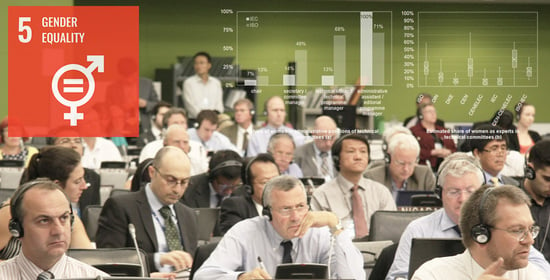SDG 5 and the Gender Gap in Standardization: Empirical Evidence From Germany
Abstract
1. Introduction
- To what extent are women represented in standardization committees?
- Why (if so) are women under-represented?
2. Literature and Theory
2.1. Initiatives on the Consideration of Gender in Standards
prevailing gender norms present barriers to women’s participation in the development of standards [and] dominance of male representation in standard-setting affects the way that standards are produced, with insufficient consideration of women specificities in the deliverables.([41], pp. 2–3)
2.2. Perspectives on Gender in Standardization
the presence of diversity balances biases, which thereby contributes to the generation of alternative perspectives and experiences for exploring new problems.
[scientific] publications of mixed teams, i.e., with a high share of female authors, receive higher citation rates than homogeneous teams [and] women have higher citation rates than men.
- general unfairness and gender inequality,
- lowered input-legitimacy,
- and, possibly, a suboptimal utilization of output-enhancing effects related to the diversity of standardization committees.
2.3. Causes of Female Under-Representation in Standardization
[men are] more heavily represented in [higher paid] engineering/technology and physical/mathematical sciences, whereas women had a much larger share of graduates in [lower paid] language studies and humanities, creative arts, and education.([65], p. 3)
2.4. Hypotheses
3. Materials and Methods
3.1. Data
3.2. Models
4. Results
4.1. Regional Differences
4.2. Size
4.3. Education
4.4. SSOs
4.5. Regression
5. Discussion
6. Conclusions
Funding
Acknowledgments
Conflicts of Interest
Appendix A
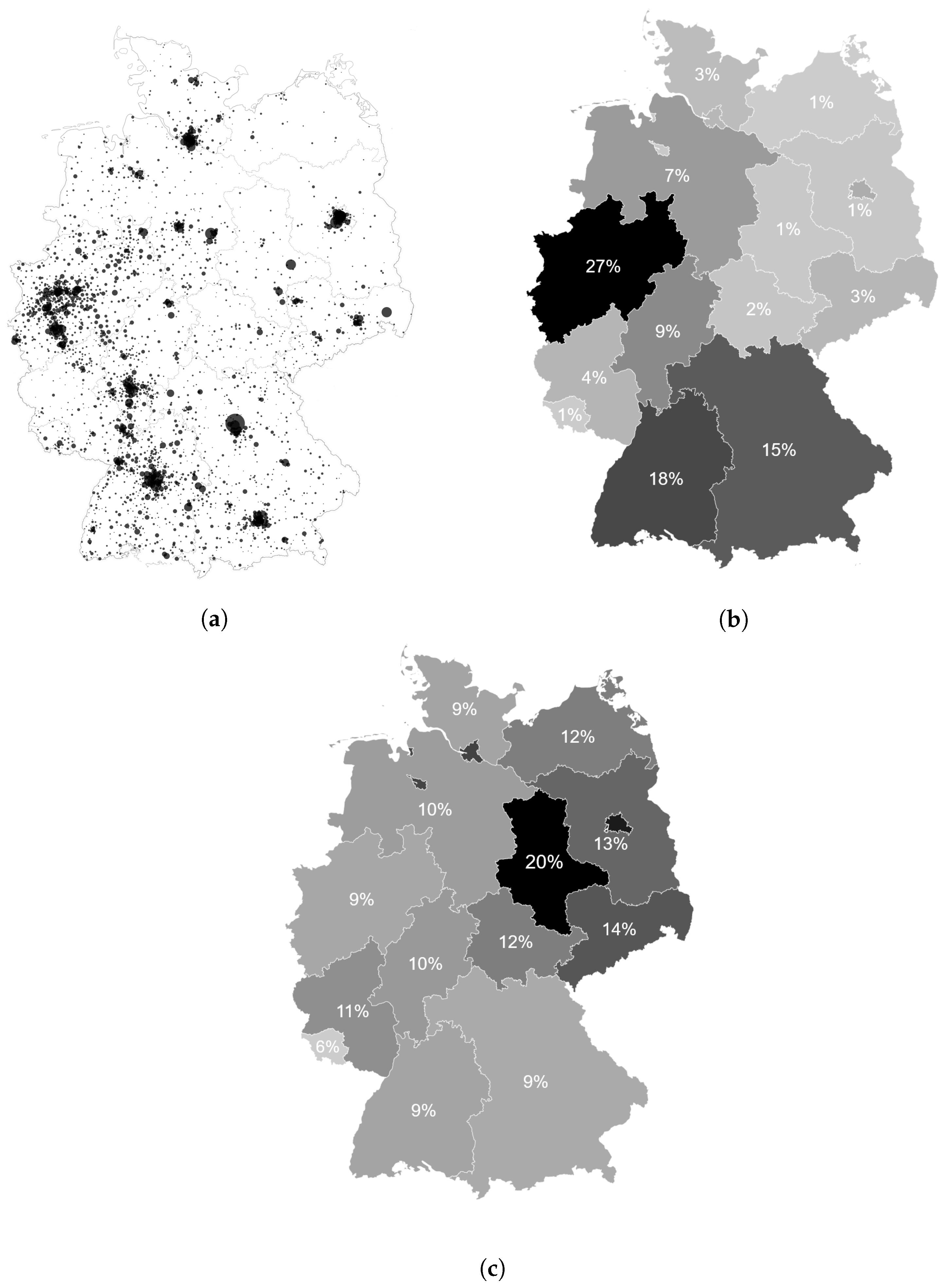
References
- Yates, J.; Murphy, C.N. Engineering Rules: Global Standard Setting Since 1880; JHU Press: Baltimore, MD, USA, 2019. [Google Scholar]
- ITU. Overview of ITU’s History. Available online: https://www.itu.int/en/history/Pages/ITUsHistory.aspx (accessed on 19 October 2020).
- Raeburn, A. IEC Technical Committee Creation: The First Half-Century (1906–1949). Available online: https://www.iec.ch/about/history/overview/history_1906_1949.htm (accessed on 19 October 2020).
- Latimer, J. Friendship among Equals: ISO’s First Fifty Years; International Organization for Standardization (ISO): Geneva, Switzerland, 1997. [Google Scholar]
- Mattli, W.; Büthe, T. Setting international standards: Technological rationality or primacy of power? World Politics 2003, 56, 1–42. [Google Scholar] [CrossRef]
- Boström, M.; Hallström, K.T. Global multi-stakeholder standard setters: How fragile are they? J. Glob. Ethics 2013, 9, 93–110. [Google Scholar] [CrossRef]
- Balzarova, M.A.; Castka, P. Stakeholders’ influence and contribution to social standards development: The case of multiple stakeholder approach to ISO 26000 development. J. Bus. Ethics 2012, 111, 265–279. [Google Scholar] [CrossRef]
- Baron, J.; Contreras, J.L.; Husovec, M.; Larouche, P.; Thumm, N. Making the Rules: The Governance of Standard Development Organizations and their Policies on Intellectual Property Rights. JRC Science for Policy Report, EUR 29655 EN. 2019. Available online: https://papers.ssrn.com/sol3/papers.cfm?abstract_id=3364722 (accessed on 19 October 2020).
- Swann, G.P. The Economics of Standardization: An Update; Report for the UK Department of Business, Innovation and Skills (BIS). 2010. Available online: http://citeseerx.ist.psu.edu/viewdoc/download?doi=10.1.1.618.5922&rep=rep1&type=pdf (accessed on 19 October 2020).
- Blind, K. The impact of standardisation and standards on innovation. In Handbook of Innovation Policy Impact; Edward Elgar Publishing: Cheltenham, UK, 2016. [Google Scholar]
- Publishing, O. Oslo Manual 2018: Guidelines for Collecting, Reporting and Using Data on Innovation; Organisation for Economic Co-operation and Development OECD: Paris, France, 2018. [Google Scholar]
- Frankel, C.; Højbjerg, E. The Political Standardizer. Bus. Soc. 2012, 51, 602–625. [Google Scholar] [CrossRef]
- Blind, K.; Mangelsdorf, A. Motives to standardize: Empirical evidence from Germany. Technovation 2016, 48, 13–24. [Google Scholar] [CrossRef]
- Borraz, O. Governing Standards: The Rise of Standardization Processes in France and in the EU. Governance 2007, 20, 57–84. [Google Scholar] [CrossRef]
- Botzem, S.; Dobusch, L. Standardization Cycles: A Process Perspective on the Formation and Diffusion of Transnational Standards. Organ. Stud. 2012, 33, 737–762. [Google Scholar] [CrossRef]
- Werle, R.; Iversen, E.J. Promoting legitimacy in technical standardization. Sci. Technol. Innov. Stud. 2006, 2, 19–39. [Google Scholar]
- Mena, S.; Palazzo, G. Input and output legitimacy of multi-stakeholder initiatives. Bus. Ethics Q. 2012, 22, 527–556. [Google Scholar] [CrossRef]
- Heß, P.; Blind, K. Company Perceptions of Legislation and Standardisation and the Voluntariness of Harmonised European Standards. EURAS Proc. 2019, pp. 185–202. Available online: https://d-nb.info/1161020586/about/lds (accessed on 19 October 2020).
- Eliantonio, M.; Cauffman, C. The Legitimacy of Standardisation as a Regulatory Technique in the EU—A Cross-disciplinary and Multi-level Analysis: An Introduction. In The Legitimacy of Standardisation as a Regulatory Technique; Edward Elgar Publishing: Cheltenham, UK, 2020. [Google Scholar]
- Canel, A.; Oldenziel, R.; Zachmann, K. (Eds.) Crossing Boundaries, Building Bridges: Comparing the History of Women Engineers 1870S–1990s; Routledge: Abingdon-on-Thames, UK, 2005. [Google Scholar]
- United Nations. Transforming Our World: The 2030 Agenda for Sustainable Development; Division for Sustainable Development Goals: New York, NY, USA, 2015. [Google Scholar]
- ITU. Meet the Women Leading Decision-making Committees at PP-18. Available online: https://news.itu.int/women-leading-committees-at-pp-18/ (accessed on 19 October 2020).
- Blind, K.; Heß, P. German Standardization Panel (DNP): Indicator Report 2019; DIN: Berlin, Germany, 2019. [Google Scholar]
- European Parliament. Equality Between Men and Women. Fact Sheets on the European Union. 2019. Available online: https://www.europarl.europa.eu/ftu/pdf/en/FTU_2.3.8.pdf (accessed on 19 October 2020).
- Jacquot, S. European Union Gender Equality Policies Since 1957. Encyclopédie pour une Histoire Nouvelle de l’Europe. 2017. Available online: http://ehne.fr/en/node/1125 (accessed on 19 October 2020).
- Bain, J.; Masselot, A. Gender equality law and identity building for Europe. Canterb. L. Rev. 2012, 18, 97–117. [Google Scholar]
- UN Women. World Conferences on Women. Available online: https://www.unwomen.org/en/how-we-work/intergovernmental-support/world-conferences-on-women (accessed on 19 October 2020).
- UN Women. Beijing Declaration and Platform for Action; UN WOMEN: New York, NY, USA, 1995. [Google Scholar]
- Sachs, J.D.; McArthur, J.W. The millennium project: A plan for meeting the millennium development goals. Lancet 2005, 365, 347–353. [Google Scholar] [CrossRef]
- UNECE. Gender Responsive Standards Initiative. Available online: https://www.unece.org/tradewelcome/tradewp6/tradewp6thematicareas/gender-responsive-standards-initiative.html (accessed on 19 October 2020).
- UNECE. Progress Report on the Gender-Responsive Standards Initiative; UNECE: Geneva, Switzerland, 2019. [Google Scholar]
- UNECE. Declaration for Gender Responsive Standards and Standards Development; UNECE: Geneva, Switzerland, 2019. [Google Scholar]
- UNECE. Country and International Standardization Bodies signing the Declaration for Gender Responsible Standards and Standards Development. Available online: http://www.unece.org/fileadmin/DAM/trade/wp6/AreasOfWork/GenderInitiative/Signatories_list_26022020.pdf (accessed on 19 October 2020).
- Jachia, L. Standards & Gender Equality. Available online: http://www.unece.org/fileadmin/DAM/trade/wp6/documents/2018/PPTs/Lorenza_Jachia_Gender-Responsive_Standards_2019.pdf (accessed on 19 October 2020).
- ISO. Goal 5: Gender Equality. Available online: https://www.iso.org/sdg05.html (accessed on 19 October 2020).
- ISO. ISO Standards Can Help Tackle Global Inequality, Says UN Women Expert. Available online: https://www.iso.org/news/ref2329.html (accessed on 19 October 2020).
- BSR. Gender Equality in Codes of Conduct Guidance; BSR: San Francisco, CA, USA, 2017. [Google Scholar]
- BSR. Gender Equality in Social Auditing Guidance; BSR: San Francisco, CA, USA, 2018. [Google Scholar]
- Jonnergård, K.; Stafsudd, A.; Elg, U. Performance Evaluations as Gender Barriers in Professional Organizations: A Study of Auditing Firms. Gender Work Organ. 2010, 17, 721–747. [Google Scholar] [CrossRef]
- Smith, S.; Busiello, F.; Taylor, G.; Jones, E. Voluntary Sustainability Standards and Gender Equality in Global Value Chains; International Centre for Trade and Sustainable Development (ICTSD): Geneva, Switzerland, 2018. [Google Scholar]
- UNECE. Gender Mainstreaming in Standards; UNECE: Geneva, Switzerland, 2016. [Google Scholar]
- Krook, M.L.; True, J. Rethinking the life cycles of international norms: The United Nations and the global promotion of gender equality. Eur. J. Int. Relat. 2012, 18, 103–127. [Google Scholar] [CrossRef]
- Schwindt-Bayer, L.A.; Mishler, W. An Integrated Model of Women’s Representation. J. Politics 2005, 67, 407–428. [Google Scholar] [CrossRef]
- Pitkin, H.F. The Concept of Representation; University of California Press: Berkeley, CA, USA, 1967; Volume 75. [Google Scholar]
- Schmidt, V.A. Democracy and Legitimacy in the European Union Revisited: Input, Output and ‘Throughput’. Political Stud. 2013, 61, 2–22. [Google Scholar] [CrossRef]
- Croson, R.; Gneezy, U. Gender differences in preferences. J. Econ. Lit. 2009, 47, 448–474. [Google Scholar] [CrossRef]
- Alsos, G.A.; Hytti, U.; Ljunggren, E. Gender and innovation: State of the art and a research agenda. Int. J. Gend. Entrep. 2013, 5, 236–256. [Google Scholar] [CrossRef]
- Bührer, S.; Yorulmaz, M. The Manifold Benefits of Gender Equality and (Responsible) Research & Innovation; EFFORTI: Evaluation Framework for Promoting Gender Equality in R&I: Karlsruhe, Germany, 2019. [Google Scholar]
- Frietsch, R.; Haller, I.; Funken-Vrohlings, M.; Grupp, H. Gender-specific patterns in patenting and publishing. Res. Policy 2009, 38, 590–599. [Google Scholar] [CrossRef]
- Hunt, J.; Garant, J.P.; Herman, H.; Munroe, D.J. Why Don’t Women Patent? IZA Discussion Papers; National Bureau of Economic Research: Bonn, Germany, 2012. [Google Scholar]
- Jung, T.; Ejermo, O. Demographic patterns and trends in patenting: Gender, age, and education of inventors. Technol. Forecast. Soc. Chang. 2014, 86, 110–124. [Google Scholar] [CrossRef]
- Intellectual Property Office. Gender Profiles in Worldwide Patenting: An Analysis of Female Inventorship (2019 Edition); Intellectual Property Office: Newport, UK, 2019. [Google Scholar]
- Blind, K.; Pohlisch, J.; Zi, A. Publishing, patenting, and standardization: Motives and barriers of scientists. Res. Policy 2018, 47, 1185–1197. [Google Scholar] [CrossRef]
- Campbell, L.G.; Mehtani, S.; Dozier, M.E.; Rinehart, J. Gender-heterogeneous working groups produce higher quality science. PLoS ONE 2013, 8, e79147. [Google Scholar] [CrossRef] [PubMed]
- Powell, A.; Hassan, T.M.; Dainty, A.R.J.; Carter, C. Note: Exploring gender differences in construction research: A European perspective. Constr. Manag. Econ. 2009, 27, 803–807. [Google Scholar] [CrossRef]
- Tower, G.; Plummer, J.; Ridgewell, B. A Multidisciplinary Study of Gender-Based Research Productivity in the World’s Best Journals. J. Divers. Manag. 2007, 2, 23–32. [Google Scholar]
- Pletzer, J.L.; Nikolova, R.; Kedzior, K.K.; Voelpel, S.C. Does Gender Matter? Female Representation on Corporate Boards and Firm Financial Performance—A Meta-Analysis. PLoS ONE 2015, 10, e0130005. [Google Scholar] [CrossRef] [PubMed]
- Blickenstaff, J.C. Women and science careers: Leaky pipeline or gender filter? Gend. Educ. 2005, 17, 369–386. [Google Scholar] [CrossRef]
- Gemeinsame Wissenschaftskonferenz GWK. Chancengleichheit in Wissenschaft und Forschung: 23. Fortschreibung des Datenmaterials (2017/2018) zu Frauen in Hochschulen und außerhochschulischen Forschungseinrichtungen; Gemeinsame Wissenschaftskonferenz GWK: Bonn, Germany, 2019. [Google Scholar]
- Anker, R. Theories of occupational segregation by sex: An overview. Int’l Lab. Rev. 1997, 136, 315. [Google Scholar]
- Preston, J.A. Occupational gender segregation trends and explanations. Q. Rev. Econ. Financ. 1999, 39, 611–624. [Google Scholar] [CrossRef]
- Miller, L.; Neathey, F.; Pollard, E.; Hill, D. Occupational Segregation, Gender Gaps and Skill Gaps; Equal Opportunities Commission: Manchester, UK, 2004. [Google Scholar]
- Cortes, P.; Pan, J. Occupation and gender. InThe Oxford Handbook of Women and the Economy; Oxford University Press: Oxford, UK, 2018; pp. 425–452. [Google Scholar]
- Eurostat. Students Enrolled in Tertiary Education by Education Level, Programme Orientation, Sex and Field of Education. Available online: https://ec.europa.eu/eurostat/web/products-datasets/-/educ_uoe_enrt03 (accessed on 19 October 2020).
- Machin, S.; Puhani, P.A. Subject of Degree and the Gender Wage Differential: Evidence from the UK and Germany. Retrieved Jan. 2002, 15, 2013. [Google Scholar] [CrossRef]
- Bundesagentur für Arbeit. Berichte: Blickpunkt Arbeitsmarkt—Die Arbeitsmarktsituation von Frauen und Männern 2018; Bundesagentur für Arbeit: Nürnberg, Germany, 2019. [Google Scholar]
- Watts, J.H. Porn, pride and pessimism: Experiences of women working in professional construction roles. Work. Employ. Soc. 2007, 21, 299–316. [Google Scholar] [CrossRef]
- Collischon, M. Is There a Glass Ceiling over Germany? Ger. Econ. Rev. 2019, 20, 313. [Google Scholar] [CrossRef]
- Kohaut, S.; Möller, I. Führungspositionen in der Privatwirtschaft: Im Osten sind Frauen öfter an der Spitze; IAB-Kurzbericht: Nürnberg, Germany, 2016; Volume 2. [Google Scholar]
- Blind, K.; Drechsler, S. European Market Needs for Education in Standardisation / Standardisation-Related Competence; European Commission: Brussels, Belgium, 2017. [Google Scholar]
- Chang, M.L. The evolution of sex segregation regimes. Am. J. Sociol. 2000, 105, 1658–1701. [Google Scholar] [CrossRef]
- BMFSFJ. Gender Equality Atlas for Germany; BMFSFJ: Berlin, Germany, 2010. [Google Scholar]
- European Commission. Women in Decision-Making Positions: Special Eurobarometer 376; European Commission: Brussels, Belgium, 2012. [Google Scholar]
- Fuchs, M.; Rossen, A.; Weyh, A.; Wydra-Somaggio, G. Why Do Women Earn More than Men in Some Regions? Explaining Regional Differences in the Gender Pay Gap in Germany; IAB-Discussion Paper: Nürnberg, Germany, 2019. [Google Scholar]
- Holst, E.; Friedrich, M. Führungskräfte-Monitor 2017: Update 1995–2015; DIW Berlin; DIW Berlin Deutsches Institut für Wirtschaftsforschung: Berlin, Germany, 2017; Volume 121. [Google Scholar]
- Cooke, L.P. Policy, preferences, and patriarchy: The division of domestic labor in East Germany, West Germany, and the United States. Soc. Politics Int. Stud. Gend. State Soc. 2006, 13, 117–143. [Google Scholar] [CrossRef]
- Singh, S.; Peers, S.M.C. Where are the Women in the Engineering Labour Market? A Cross-Sectional Study. Int. J. Gend. Sci. Technol. 2019, 11, 203–231. [Google Scholar]
- Statistisches Bundesamt. German Classification of Economic Activities, Edition 2008. Available online: https://www.destatis.de/DE/Methoden/Klassifikationen/Gueter-Wirtschaftsklassifikationen/Downloads/klassifikation-wz-2008-englisch.html (accessed on 19 October 2020).
- Papke, L.E.; Wooldridge, J.M. Econometric methods for fractional response variables with an application to 401 (k) plan participation rates. J. Appl. Econ. 1996, 11, 619–632. [Google Scholar] [CrossRef]
- IEC. List of IEC Technical Committees and Subcommittees. Available online: https://www.iec.ch/dyn/www/f?p=103:6:12710394311485::::FSP_LANG_ID:25/txt/sc3d.htm (accessed on 31 January 2020).
- ISO. Technical Committees. Available online: https://www.iso.org/technical-committees.html (accessed on 31 January 2020).
- Childs, S.; Krook, M.L. Critical Mass Theory and Women’s Political Representation. Political Stud. 2008, 56, 725–736. [Google Scholar] [CrossRef]
- Lauring, J.; Villesèche, F. The Performance of Gender Diverse Teams: What Is the Relation between Diversity Attitudes and Degree of Diversity? Eur. Manag. Rev. 2019, 16, 243–254. [Google Scholar] [CrossRef]
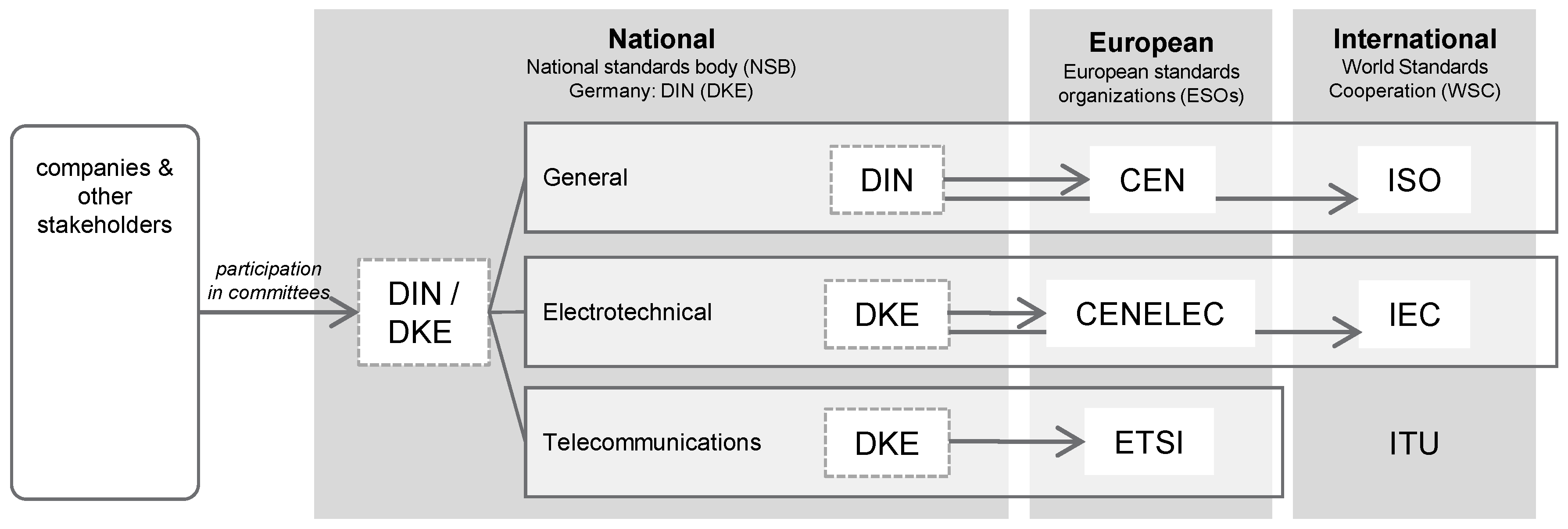


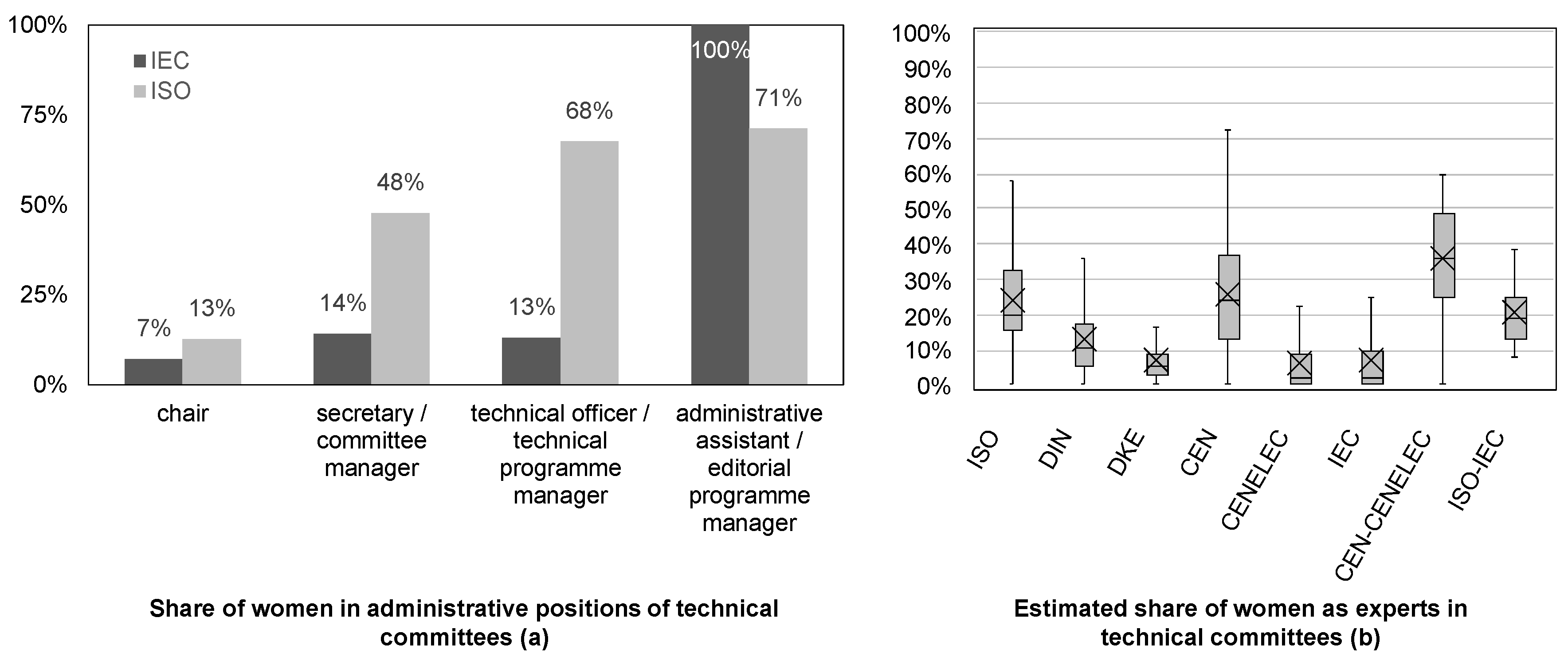
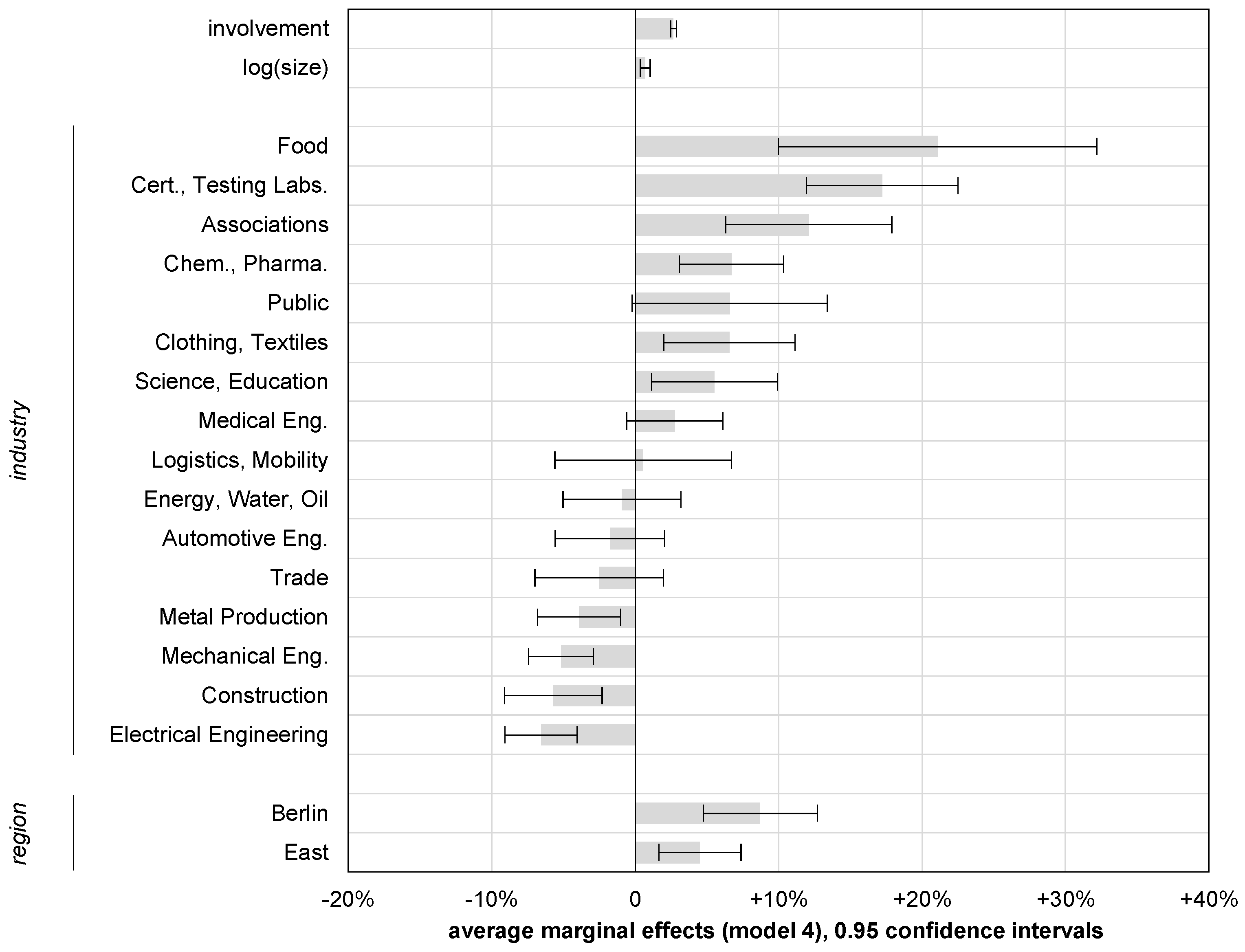
| Variable | Women = 1 (%) | Obs. | Mean | Std. Dev. | ||
|---|---|---|---|---|---|---|
| dependent | Logistic regression model. Equal to 1 if an organization is represented by at least one female expert, otherwise 0 | 16.7 | 8134 | |||
| dependent | Fractional logit model. Fraction of female experts affiliated with organization | |||||
| independent | Cert., Test. Labs | 42.0 | 317 | |||
| Public | 39.0 | 136 | ||||
| Food | 35.5 | 62 | ||||
| Associations | 32.6 | 221 | ||||
| Science, Edu. | 31.1 | 325 | ||||
| Chem., Pharma. | 24.2 | 541 | ||||
| Energy, Water, Oil | 21.9 | 269 | ||||
| Logistics, Mobility | 21.6 | 125 | ||||
| Automotive Eng. | 20.7 | 309 | ||||
| Medical Eng. | 19.6 | 560 | ||||
| Clothing, Textiles | 18.9 | 334 | ||||
| Service | 11.4 | 1827 | ||||
| Mechanical Eng. | 11.2 | 1326 | ||||
| Metal Prod. | 11.0 | 619 | ||||
| Electrical Eng. | 10.8 | 753 | ||||
| Trade | 10.5 | 229 | ||||
| Construction | 7.5 | 361 | ||||
| Primary | 14.3 | 888 | ||||
| Secondary | 15.2 | 4246 | ||||
| Tertiary | 19.4 | 3180 | ||||
| Berlin | 31.4 | 388 | ||||
| East Germany | 20.7 | 666 | ||||
| West Germany | 15.6 | 7260 | ||||
| Number of employees | 8134 | 2649 | 21,771 | |||
| Micro: <10 | 10.9 | 1364 | ||||
| Small: 10–49 | 12.8 | 1718 | ||||
| Medium: 50–249 | 14.7 | 2345 | ||||
| Large: 250–999 | 18.3 | 1605 | ||||
| Larger:≥1000 | 30.2 | 1282 | ||||
| control | Total number of experts affiliated with organization (experts = employees active in standardization) | 8134 | 3.5 | 8.5 |
| Models | Logistic Regression | Fract. Logit | ||||
|---|---|---|---|---|---|---|
| (1) | (2) | (3) | (4) | (5) | ||
| 0.028 *** | 0.028 *** | 0.028 *** | 0.027 *** | 0.000 ** | ||
| (0.001) | (0.001) | (0.001) | (0.001) | (0.000) | ||
| 0.005 ** | 0.007 *** | 0.007 *** | 0.007 *** | 0.003 ** | ||
| (0.002) | (0.002) | (0.002) | (0.002) | (0.001) | ||
| Secondary | 0.015 | 0.016 | ||||
| baseline Primary | (0.011) | (0.011) | ||||
| Tertiary | 0.071 *** | 0.064 *** | ||||
| (0.012) | (0.012) | |||||
| Berlin | 0.099 *** | 0.087 *** | 0.044 *** | |||
| baseline west | (0.021) | (0.020) | (0.013) | |||
| East | 0.054 *** | 0.045 ** | 0.029 ** | |||
| (0.015) | (0.015) | (0.010) | ||||
| Associations | 0.121 *** | 0.077 *** | ||||
| baseline Service | (0.030) | (0.019) | ||||
| Automotive Eng. | −0.017 | −0.017 | ||||
| (0.019) | (0.011) | |||||
| Chem., Pharma. | 0.067 *** | 0.050 *** | ||||
| (0.019) | (0.014) | |||||
| Clothing, Textiles | 0.066 ** | 0.051 ** | ||||
| (0.023) | (0.018) | |||||
| Construction | −0.057 *** | −0.037 *** | ||||
| (0.017) | (0.011) | |||||
| Electrical Eng. | −0.066 *** | −0.036 *** | ||||
| (0.013) | (0.008) | |||||
| Energy, Water, Oil | −0.009 | 0.000 | ||||
| (0.021) | (0.014) | |||||
| Food | 0.211 *** | 0.180 *** | ||||
| (0.057) | (0.048) | |||||
| Logistics, Mobility | 0.006 | 0.023 | ||||
| (0.031) | (0.023) | |||||
| Mechanical Eng. | −0.052 *** | −0.036 *** | ||||
| (0.012) | (0.007) | |||||
| Medical Eng. | 0.028 | 0.011 | ||||
| (0.017) | (0.011) | |||||
| Metal Production | −0.039 ** | −0.025 ** | ||||
| (0.015) | (0.009) | |||||
| Public | 0.066 | 0.062 ** | ||||
| (0.035) | (0.022) | |||||
| Cert., Testing Labs. | 0.172 *** | 0.120 *** | ||||
| (0.027) | (0.019) | |||||
| Science, Education | 0.055 * | 0.041 ** | ||||
| (0.022) | (0.015) | |||||
| Trade | −0.025 | −0.014 | ||||
| (0.023) | (0.016) | |||||
| Const | −2.744 *** | −3.195 *** | −3.267 *** | −2.952 *** | −2.782 *** | |
| (0.081) | (0.138) | (0.139) | (0.099) | (0.104) | ||
| Observations | 8314 | 8314 | 8314 | 8314 | 8314 | |
| Pseudo | 0.159 | 0.167 | 0.172 | 0.200 | 0.047 | |
| AIC | 6322 | 6270 | 6233 | 6053 | 4515 | |
Publisher’s Note: MDPI stays neutral with regard to jurisdictional claims in published maps and institutional affiliations. |
© 2020 by the author. Licensee MDPI, Basel, Switzerland. This article is an open access article distributed under the terms and conditions of the Creative Commons Attribution (CC BY) license (http://creativecommons.org/licenses/by/4.0/).
Share and Cite
Heß, P. SDG 5 and the Gender Gap in Standardization: Empirical Evidence From Germany. Sustainability 2020, 12, 8699. https://doi.org/10.3390/su12208699
Heß P. SDG 5 and the Gender Gap in Standardization: Empirical Evidence From Germany. Sustainability. 2020; 12(20):8699. https://doi.org/10.3390/su12208699
Chicago/Turabian StyleHeß, Philipp. 2020. "SDG 5 and the Gender Gap in Standardization: Empirical Evidence From Germany" Sustainability 12, no. 20: 8699. https://doi.org/10.3390/su12208699
APA StyleHeß, P. (2020). SDG 5 and the Gender Gap in Standardization: Empirical Evidence From Germany. Sustainability, 12(20), 8699. https://doi.org/10.3390/su12208699




